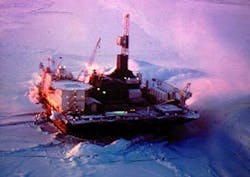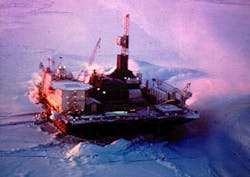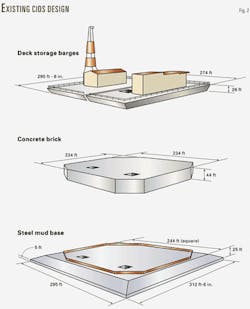This article is a late-breaking adjunct to the special report that begins on p. 54.
The multinational Sakhalin I consortium led by ExxonMobil Corp. has acquired Global Marine Inc.'s Glomar Beaufort Sea I concrete-island drilling system (CIDS), for offshore development of the Chayvo field east of Sakhalin Island, as part of the Sakhalin I, Phase-1 project (Fig. 1).
Global Marine entered into an agreement with the ExxonMobil-led consortium in March 2001 to sell the CIDS for $45 million. The deal, which was completed before the end of June, called for a $5 million down payment with the remainder plus accrued interest payable on or before Mar. 1, 2003.
The CIDS will be moved this summer from the Beaufort Sea to a yet-to-be-named contractor in the Far East, where major modifications will convert it into a drilling and production facility.
In addition to the CIDS deployment, the consortium will use shore-based, extended-reach drilling to develop the Odoptu field and the northern portion of the Chayvo field.
The Sakhalin I, Phase 1 project will be an oil-only development with a peak production target of 250,000 b/d.
Although Phase-1 is an oil-only project, marketing of gas from the Sakhalin I blocks continues. Japan, China, and Russia have expressed interest in purchasing the gas.1
Development planning activities are progressing and start-up is likely by yearend 2005. ExxonMobil has 30% interest in the project through its subsidiary, Exxon Neftegas Ltd., operator for the consortium, and projects the total Phase-1 project investment to be $3.7 billion.
The Japanese company Sakhalin Oil and Gas Development Co. Ltd. has a 30% interest and Russian companies Sakhalinmorneftegas-Shelft and Rosneft-Sakhalin each has 23% and 17% interest in the project, respectively.1
CIDS
The Glomar Beaufort Sea I is a mobile drilling unit designed specifically for year-round exploratory drilling in harsh offshore arctic environments. It is capable of deployment in water depths ranging 35-52 ft and drilling to 25,000 ft.
The CIDS has a steel mud base, a center structure of honeycombed concrete referred to as the "Brick," two steel deck storage barges, the quarters unit, and the drilling rig (Fig. 2).
A series of large tanks in the steel mud base can be flooded with seawater to provide ballast control during the lowering or refloating of the platform.
The ice loads are transmitted from the Brick to the foundation soil through the steel mud base. A 5-ft deep grid, which extends beneath the base penetrating the soil, prevents the CIDS from sliding.
The concrete Brick supports the two deck storage barges, providing a total of more than 79,000 sq ft of deck space, internal areas for machinery spaces, and storage for fuel and consumables.
The quarters are installed on the starboard barge. The drill rig and all drilling support equipment are on the port barge. Multiple wells can be drilled at the single platform location.
The drilling rig currently aboard is a standard 2,000-hp land rig, which was modified to meet the USGC MODU regulations for offshore operations.
The Sakhalin I consortium has not determined or disclosed the scope of modifications required for CIDS before deployment at Chayvo. Given its role as a drilling and production facility, however, the system must accommodate multiple wells and associated production equipment.
The CIDS has drilled five wells since it was built. During its first two winter drilling seasons (1984-85 and 1985-86), Exxon used it to drill three Antares prospect wells in the Beaufort Sea just northwest of Harrison Bay.
ARCO Alaska Inc. and Phillips Petroleum Co. drilled the 1-Stinson well in the Camden Bay area 6 miles east of undeveloped Point Thomson gas and condensate field, during winter 1989-90. Field sources reported that the well was a tight hole, drilled to about 15,500 ft.
ARCO Alaska Inc. used the CIDS to drill the Warthog, a well in Camden Bay off the Arctic National Wildlife Refuge (ANWR) coast, during 1997-98.
Global Marine moved the CIDS from Camden Bay back to near Prudhoe Bay, during the 2000 summer thaw, where it currently sits.
Bruce Watson, vice-president of operations support, Global Marine Inc., said "The Beaufort Sea I doesn't appear to have aged at all. It's in great shape and looks just as it did when it drilled the first well in 1984."
Weather conditions
The Sea of Okhotsk often experiences dangerous storm winds, severe waves, icing of vessels, intense snowfalls, and poor visibility.
Typhoons can be frequent in summer, producing not only heavy rain, but also severe winds and waves. Wave heights normally range 3-10 ft but can reach as high as 60 ft during extreme storm conditions.
Offshore structures must contend with icing from October through to December, averaging 187 days, with ice sheets moving at speeds of 1-2 knots. The average annual extreme low temperature is about -30° F.
Operators, developing fields offshore Sakhalin, have no choice but to employ structures that are specifically designed for the harsh arctic environment.
The Molikpaq single-anchor-leg-mooring (SALM) system was the first such drilling and production platform used offshore Sakhalin. Installed at the Piltun Astokhskoye field in September 1998, the Molikpaq has a steel and concrete hull with a sand or gravel inner core.
The Glomar Beaufort Sea I CIDS will be the second arctic system to be installed in the Sea of Okhotsk. The CIDS is ideal for the task, since it was designed to operate in the Beaufort Sea, which experiences some of the most severe ice conditions in the world with thick first-year ice, multi-year floes and large pressure ridges comprising the winter ice cover.2
Field delineations
Last September ExxonMobil announced that the Chayvo-6 appraisal well had encountered an oil-bearing Miocene sandstone reservoir stepout that flowed at a test rate of 6,000 b/d. The well was drilled in 50 ft of water to a TD of 10,089 ft.
Geoscientists, using 3D seismic technologies, determined that a large 340-ft oil column exists in the stepout on Chayvo field's west flank.
Engineers and geologists had known that Chayvo possessed enormous gas reserves prior to the Chayvo-6 delineation well, with current estimated recoverable reserves of almost 11 tcf.
Discovered in 1979, Chayvo is about 370 miles north of Yuzhno-Sakhalinsk.
Two other fields in addition to Chayvo, make up the Sakhalin I reserves. Odoptu and Arkutun-Dagi were discovered in 1977 and 1989, respectively. Currently, the consortium has drilled 31 exploration and delineation wells in the three fields.
The Chayvo-6 well and previous appraisal work have identified estimated recoverable reserves on the Sakhalin I blocks totaling 2.5 billion bbl of oil and 17 tcf of gas (Fig. 3).
2001 plans
The consortium is focusing its work on the outstanding engineering design, including studies, surveys, and other regulatory approvals.
Geoscientists and engineers must complete interpretation of Chayvo-6 well results, conduct several field surveys, including Odoptu 3D seismic survey, and complete front-end engineering and design for onshore and offshore facilities and progress project approvals.
The 2001 work plans and budget, which were approved by the authorized state body on Feb. 6, 2001, provides for expenditures of more than $150 million.
As the consortium continues its effort to market Sakhalin I gas to major export customers in Japan and China, it is also working to establish a commercial framework to support gas sales to potential buyers in Far East Russia.
Gas to Japan
Even though Sakhalin I, Phase-1 is an oil only project, the consortium has been working diligently to market the gas. With 17 tcf of recoverable gas reserves, Sakhalin I could supply 1.5-2 bcfd over a plateau life of several decades.
During a recent press conference in Japan, Neil Duffin, president of Exxon Neftegas Ltd. explained the potential benefits of a natural gas import pipeline from Sakhalin Island to the Japanese market.1
- It will provide a new source of gas supply and method of delivery.
- Like LNG, natural gas would be clean, safe, and reliable energy.
- Natural gas would be competitively priced with market alternatives.
- Natural gas from the pipeline would complement LNG, adding security and flexibility.
A pipeline consortium formed in April 1999 to study the feasibility of a Sakhalin-to-Japan pipeline, with members Japan Petroleum Exploration Co. Ltd., Itochu Corp., and Marubeni Corp. (75%) and Exxon Japan Pipeline Ltd. (25%).
The consortium-defined work scope was to determine technical and economic feasibility, including route selection, design codes, regulatory, and right-of-way.
Offshore surveys including landfalls and the Hokkaido route crossing selection have been completed (Fig. 4).
By yearend 2001, the pipeline consortium expects to complete conceptual engineering, cost estimates, and project specific design code recommendations, with remaining study items completed by April 2002.
Gas deliveries to Japan could begin about 5 years after firm commitments are made for sufficient volumes, provided there is close cooperation resolving governmental issues.
References
- Duffin, N., "Sakhalin I Natural Gas Pipeline Project Benefits for Japan," press conference, Tokyo, June 14, 2001.
- Gaida, K.P., Loh, J.K.S., Mitton, F.E., Pidcock, B.A., Wright, B.D., "An alternative for shallow water oilfield development in arctic waters," SPE Paper No. 23085, presented at the Offshore Europe Conference, Aberdeen, Sept. 3-6, 1991.




